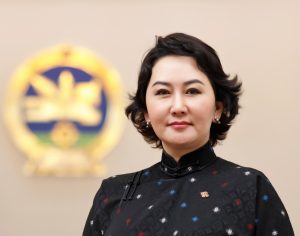Last year, Mongolia celebrated its 110th anniversary as an independent country. Along with that, modern Mongolia has notched 110 years of national diplomacy. Amid the task of foreign policymaking, the foreign ministry has also made developments in diversifying its workforce. The current office of the foreign ministry appointed the highest number of female ambassadors in the history of modern Mongolia.
Male figures have often carried out state and foreign affairs throughout Mongolia’s history. Historians and international relations scholars enjoy an abundance of literature on male Mongol leaders, dating back to the 13th century and Chinggis Khan. “The Secret History of the Mongols” illustrates the political and personal cult of male leaders, one generation after another. In modern Mongolia (starting from the Mongolian Revolution in 1911) literature on past rulers Bogd Khan, Choibalsan Khorloo, and Tsedenbal Yumjaa, followed by the six democratically elected presidents, is also abundant.
However, only on rare occasions – mostly in historical folk tales and anecdotes – can one find mentions of these leaders’ daughters and wives’ participation in nation-building ideologies and political discussions. Unfortunately, since much of this literature is published in Mongolian – some in Mongol bichig script – thus, the scope of the readership is limited, especially abroad.
Mongolian female figures are historically well known, such as Chinggis Khan’s birth mother, Uelun Khatan and his wife, Borte Ujin. Mandukhai Tsetsen Khatan, known as the “Mandukhai the Wise,” possessed intellect, courage, and foresight that helped shape the Mongol policy toward the Ming rulers and united the warring Mongol tribes. However, these women generally only appear in the periphery of a larger historical context. A woman was almost never the historical focus in her own right until recent times.
Jack Weatherford’s “The Secret History of the Mongol Queens: How the Daughters of Genghis Khan Rescued His Empire” is one of the most critical modern pieces of literature that highlight these shortcomings. He notes that the attempt to relegate Mongolian women to historical footnotes is longstanding. As Weatherford wrote, “On an unknown day late in the thirteenth century, an unidentified hand clumsily cut away part of the text from the most politically sensitive section of The Secret of the Mongols. Through oversight or malice, the censor left a single short sentence of the mutilated text that hinted at what had been removed: ‘Let us reward our female offspring.’”
Despite these historical misfortunes, modern Mongolia paints a different picture. Women have regained space and opportunities to participate in politics and foreign affairs once again, with gender equality efforts part of the policymaking.
Mongolia’s experience in its 1990s democratization forced policymakers to include women as part of state diplomacy. As a result, women began to take initiatives to boost their presence in government service, such as holding diplomatic positions, serving in U.N. peacekeeping missions, entering the military, being elected as parliamentary members – all with significant contributions to strengthening Mongolia’s diplomacy as a whole.
On January 19, 2022, the Parliament of Mongolia approved the Foreign Ministry’s appointment of two female diplomats. A long-time diplomat, Sarantogos Erdenetsogt, was appointed as the ambassador to South Korea, and Gerelmaa Davaasuren was appointed as the ambassador to Switzerland. Before that, in late December 2021, Nyamkhuu Ulambayar was appointed as ambassador to France, marking the first female diplomat to head the Mongolian mission there. As an ambassador to France, her mission also includes strengthening relations with Spain, Portugal, Monaco, and Andorra.
With these appointments, Mongolia officially set its record for the most female ambassadors serving at a given time. In a celebratory tone, Foreign Minister of Mongolia Battsetseg Batmunkh – one of Mongolia’s female diplomats herself – stated in a tweet, “In the history of the Mongol diplomacy, Mongolia now has the highest number of female ambassadors, six out of 31 ambassadors.”
During the latest parliamentary session, former Prime Minister Batbold Sukhbaatar stated, “I believe that the appointment of these two qualified individuals is timely and efficient. But more importantly, as countries continue to combat the economic fallout of the COVID-19 global pandemic, I hope that the newly appointed diplomats will initiate tangible ways to strengthen the bilateral economic relations between the nations.”
As Mongolian diplomacy continues to strive for peaceful existence as well as equal opportunities and human rights, the inclusion of women, especially the appointment of female ambassadors, is indeed a milestone. Gender equality is an issue that requires continued efforts and attention in the Foreign Ministry, the military, and other leading sectors.

































